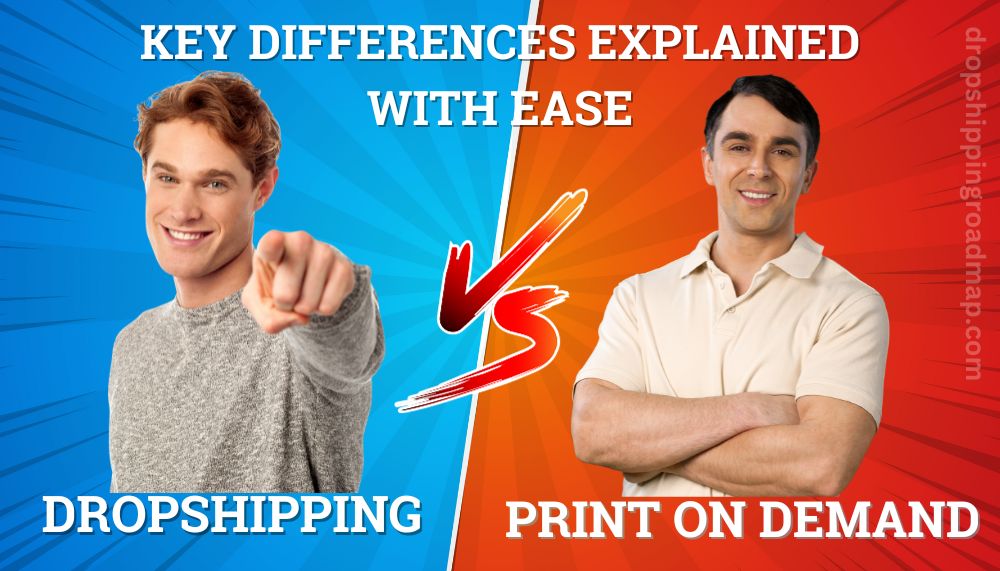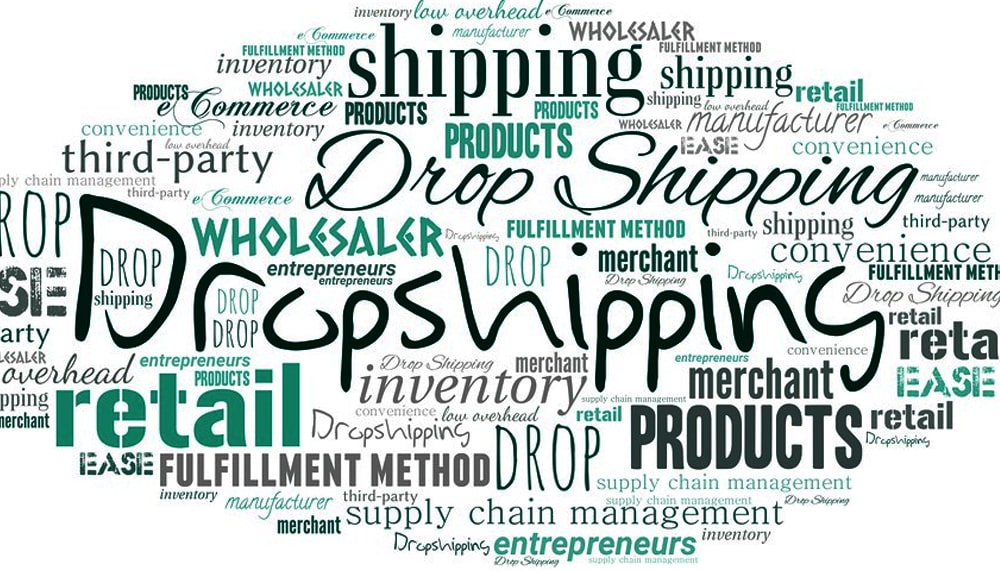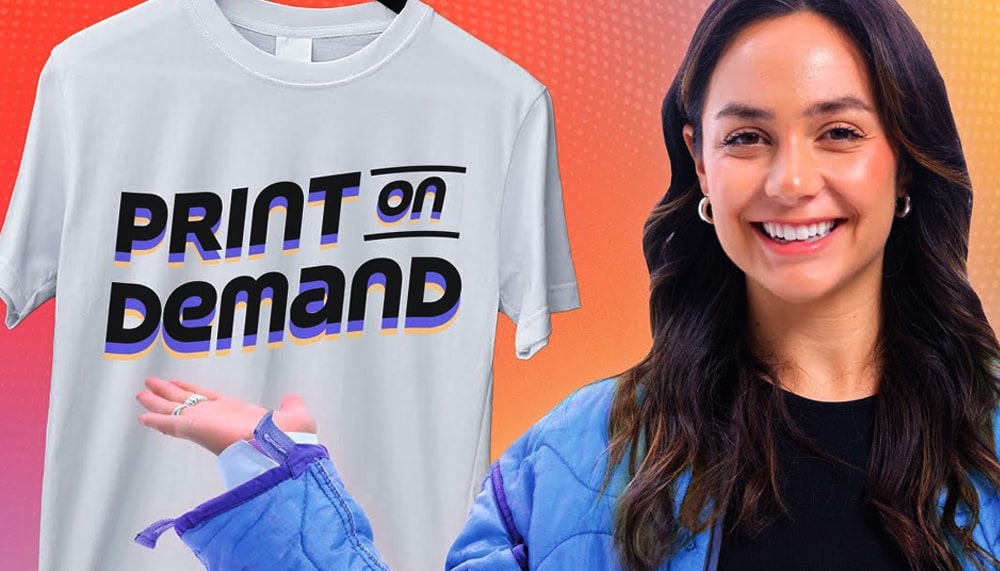E-commerce and passive income models are all the rage these days. Who wouldn’t want to earn money while sitting poolside with a fancy drink in hand?
But with so many options out there, how do you know which business model to choose?
Two of the most popular e-commerce models right now are Dropshipping and Print-On-Demand (POD). They both allow you to sell products online without holding any inventory or handling logistics. Sounds pretty sweet, right?
However, Dropshipping and POD have some key differences that you need to understand before diving in.
This article “Dropshipping vs. Print On Demand (POD)” will compare the two side-by-side to help you determine:
- What is dropshipping and POD?
- How do they work?
- What are the pros and cons of each?
- Which model aligns better with your goals, skills, and interests?

Article Contents
- 1 Dropshipping vs. Print on Demand – Quick overview of how they stack up
- 2 What is Dropshipping?
- 3 What is Print on Demand?
- 4 Similarities Between Dropshipping and POD
- 5 Key Differences Between Dropshipping and POD
- 6 Case Studies and Examples
- 7 Which Model is Better For You?
- 8 Getting Started Guides
- 9 Dropshipping vs. Print on Demand – Conclusion
- 10 FAQs on Dropshipping vs. Print On Demand
Dropshipping vs. Print on Demand – Quick overview of how they stack up
| Model | Dropshipping | Print-on-Demand |
| Product types | Almost anything | Custom products like t-shirts, mugs, etc. |
| Customization | Low | High |
| Profit margins | Higher | Lower |
| Competition | High | Medium |
By the end, you’ll have a solid grasp of both business models so you can decide which one is the best fit to help you get started with your passive income e-commerce dream.
Let’s get started.
What is Dropshipping?

Let’s start by getting clear on what exactly dropshipping is.
Definition
The textbook definition goes something like this:
Dropshipping is a retail fulfillment method where a store doesn’t keep the products it sells in stock.
Instead, when a store sells a product using the dropshipping model, it purchases the item from a third party and has it shipped directly to the customer.
In plain English, this means:
- You (the dropshipper) set up an online store and list products to sell
- You market and sell the products to customers
- When a sale comes in, you forward the order details to your supplier
- The supplier then ships the product directly from their warehouse to the customer
- So you never see or touch the actual products.
How It Works
Here is the full dropshipping process in 5 steps:
- Set up an online storefront
- Add product listings
- Promote products and make sales
- Forward orders to suppliers
- Supplier ships products to customers
Benefits
- No inventory overhead
- Very little startup capital
- Automated fulfillment process
Dropshipping Business Model
As a dropshipper, you can focus on sales and marketing without worrying about production, packaging, or shipping.
You keep the profit margin between what you charge the customer and what you pay the supplier. With the right suppliers and products, margins can reach 50% or higher.
Most successful dropshipping stores target niche markets where they can command higher prices because of their specialized offerings.
Overall, dropshipping represents an affordable and flexible e-commerce business model for aspiring entrepreneurs or passive income seekers. The barrier to entry is low, but competition can be high.
Also READ:
What is Print on Demand?

Now that we know what dropshipping is all about, let’s contrast it with print on demand (POD).
Definition
Print-on-demand refers to a service model where products like t-shirts, mugs, and phone cases are only printed when a customer places an order. The products are customized, printed on-demand, and shipped directly to the customer.
So in short:
- You set up an online POD storefront
- Customers order customized products
- The print provider manufactures the product when an order comes in
- Provider ships completed product directly to the customer
- No sitting on inventory or handling logistics.
How It Works
The typical print-on-demand workflow is:
- Set up an online POD store
- The customer places an order for a custom product
- Order details sent to print provider
- Provider prints product, handles packaging and shipping
- Provider fulfills orders directly to the customer
Benefits
- Zero upfront costs
- Customized product offerings
- Automated fulfillment
Print-on-Demand Business Model
As a POD store owner, you get to focus fully on design, marketing, and sales. The manufacturing and shipping are entirely hands-off.
You earn a profit on each sale by pricing the products higher than the base printing price. Profit margins can vary quite a bit depending on the types of products you offer.
Many successful POD stores build an audience first through content marketing and social media presence before launching products. This establishes trust and authority around the brand designs.
Overall, POD offers entrepreneurs and artists a platform to sell customized physical products with minimal financial risk.
Similarities Between Dropshipping and POD
Despite some clear differences already apparent, dropshipping and print-on-demand share quite a few similarities that make them appealing passive income models:
No Inventory Required
One of the best parts of dropshipping and POD is not having to hold any inventory. Products are either:
- Shipped directly from the supplier (dropshipping)
- Manufactured on-demand when ordered (POD)
This means no worrying about:
- Forecasting demand
- Stocking inventory
- Managing a warehouse
Talk about nice. Both models allow you to run lean.
Low Startup Costs
To launch a dropshipping or POD business, you can get started with:
- A laptop and internet
- A Shopify store or Etsy shop
- Some marketing budget
- Lots of hustle
The startup costs for both are super reasonable to test and validate an idea. Expect just a few hundred to a few thousand dollars to get up and running.
Low Risk
With no expensive inventory sitting around, POD and dropshipping businesses carry minimal financial risk:
- Limited upfront costs
- Inventory is produced only when needed
- Easy to pivot if the initial product doesn’t sell
You won’t find yourself stuck with 1,000 units of unsold niche products (I speak from experience).
Passive Income Potential
Both models allow entrepreneurs, artists, and side hustlers to earn passive income:
- Receive orders and fulfillment handled for you
- Very scalable with primarily fixed costs
- Semi-automated sales process
Do the work once when setting up your store, then manage a few hours per week while you collect checks.
This makes it appealing to people with little free time.
Wide Range of Products
Dropshippers can sell almost any consumer product:
- Home goods
- Beauty supplies
- Pet products
- Kitchenware
- Toys
- And more.
For POD, millions of designs are possible on products like:
- T-shirts
- Mugs
- Posters
- Phone cases
- Hats
- And more.
If you can dream it, you can sell it.
Easy to Start and Experiment
All you need is an idea, a store, and some hustle to get started. No formal business training is required.
This low barrier makes validating ideas and tweaking your store super simple. Fail fast, learn quicker.
Overlapping Skill Sets
No matter which model you choose, the same baseline skills are required:
- Digital marketing: SEO, social ads
- Graphic design: Visuals, branding
- Basic financial and data analysis
Leverage platforms like Shopify to shortcut tech lift. Focus more on selling.
So in many ways, dropshipping and POD enable entrepreneurship for the masses. But they have some clear distinctions too.
Key Differences Between Dropshipping and POD
While dropshipping and POD share some similarities, they part ways in a few fundamental areas:
Products
The types of products you sell with each model vary quite a bit:
Product Range
- Dropshipping: Offer millions of products from cross-border suppliers and wholesalers. Everything from homewares to phone accessories to clothing and beyond.
- POD: Focus on customized and made-to-order products. Mainly apparel, phone cases, art prints, mugs, and other customizable gift items.
Product Cost
- Dropshipping: Preset product cost from suppliers. Low profit margins, high order values.
- POD: You set the pricing based on production costs. Higher margins potential, lower order values.
Quality Control
- Dropshipping: Varies by supplier. Generally lower for cheap Chinese factories.
- POD: Companies invest heavily in state-of-the-art printers and materials. Highly consistent.
So dropshippers offer a wider variety but less input on product details. POD store owners focus on fewer product types but customize everything.
Customization Options
With PRINT-ON-DEMAND, you get to put your designs, artwork, or branding on products. This personalization ability attracts buyers who want one-of-a-kind items.
Most dropshipping suppliers don’t offer heavy product customization since they mass-produce generic products.
So if creating unique products aligned with your branding is important, POD has a leg up.
Order Fulfillment & Shipping
The order preparation and delivery process varies quite a bit between models:
Production & Shipping Time
- Dropshipping: 2-4 weeks from order to doorstep. Long transit times.
- POD: 1-3 days production time. Fast delivery.
Shipping Costs
- Dropshipping: Low-cost shipping from China/overseas. Slow boat.
- POD: Faster shipping but charges are higher.
POD provides much faster order turnaround time and domestic shipping. So customers get purchases quicker compared to dropshipping.
Case Studies and Examples
To bring dropshipping and POD to life, let’s look at some real-world examples of successful stores.
Successful Dropshipping Stores
- Pet food niche store: Focused specifically on natural and organic pet food. Curated top-selling products in a specific niche to command higher margins from repeat purchases. Low competition in narrow niches helped SEO rankings.
- Jewelry dropshipping store: Imported inexpensive but good quality jewelry from suppliers in China and India. Strong social media and influencer marketing presence established authority. High average order values over $100.
- Toy store for educators: Sold unique toys and learning tools to teachers and parents. Developed strong content and community to gain trust around curated products. Monthly subscriptions and loyalty programs retained customers.
Successful POD Stores
- Minimalist art prints: Leveraged Instagram to build a highly engaged audience for minimalist art style. Used audience insights to iterate on best-selling prints. Part proceeds were donated to charities which amplified the mission.
- Yoga apparel brand: Created aspirational branding around the yoga lifestyle. Niche focus allowed premium pricing and margins on leggings and tops. Online courses and membership sites diversified revenue streams.
- Travel community products: Grew initial audience through a travel blog and online community. Later POD products aligned with their brand story. Viral giveaways incentivized UGC and word-of-mouth.
As you can see, both models can produce highly successful stores when targeted to specific niches. But should you choose one over the other?
Let’s weigh them head-to-head.
Which Model is Better For You?
With all the similarities and differences in mind – how do you determine what business model to pursue?
Goals, Skills, and Interests
At the end of the day, it comes down to aligning with your profile:
- What are your revenue goals – high margin or high volume?
- Do you enjoy design and creativity or sourcing and systems?
- Are you willing to invest time upfront in exchange for more customization ability long-term?
There’s no universally “better” model. It depends on your aspirations and strengths.
Hybrid Model
You don’t necessarily have to choose just one business model either. Some entrepreneurs run hybrid storefronts:
- Primary POD store with some dropshipped evergreen products
- Supplementary POD merchandise to complement core dropshipping catalog
Get the best of both worlds when it aligns with your goals.
SWOT Analysis
Here is a SWOT breakdown to directly compare the strengths, weaknesses, opportunities, and threats of each model:
| Dropshipping | Print-on-Demand | |
| Strengths | Wide product selection Higher profit margins | Unique custom productsBranding control |
| Weaknesses | Long shipping times Limited customization | Lower profit ceiling Fewer product categories |
| Opportunities | Expand to multi-channel sales Private label products | Grow social following before launch Expand packaging and branding |
| Threats | Rising advertising costs Quality control issues | Design theft Market saturation |
Analyze how each aligns with what you bring to the table along with your e-commerce goals. Of course, the best way to find out is to test ideas hands-on.
So let’s look at getting started.
Getting Started Guides
Ready to dive in? Here is a step-by-step overview of launching each business model for the first time:
Getting Started With Dropshipping Step-by-Step Guide
Follow this beginner’s guide to kickstarting your first dropshipping store:
- Choose a niche: Select based on product viability, competition, and profitability.
- Set up your store: Use a platform like Shopify or WooCommerce. Add branding, store design, etc.
- Find reliable suppliers: Evaluate suppliers like Oberlo. Assess costs, shipping times, and product selection.
- List products from suppliers: Upload products + details to align with brand.
- Marketing and sales: Run promotions and ads to generate first sales. Offer coupons or free shipping.
- Delight customers: Ensure fast shipping and good quality products. Solidify positive reviews.
- Analyze data: Use analytics to determine winning products. Tweak listings and prices accordingly.
- Scale: Reinvest profits into marketing and automation. Expand the catalog over time.
Follow this roadmap while customizing store details to your niche. Learn as you go.
Getting Started With Print On Demand Step-by-Step Guide
Follow this beginner’s guide to launching your first POD store:
- Choose a niche: Pick an area you’re passionate about that fits POD products.
- Develop custom designs: Brainstorm creative designs that customers will love.
- Set up a print account: Create an account with a provider like Printful to handle orders.
- Launch online store: Build a Shopify or Etsy storefront to sell designs.
- Market on social: Run targeted ads to your niche buyers. Develop organic content.
- Offer promotions: Offer discounts or product giveaways to gain awareness.
- Analyze sales data: See which designs sell best. Tweak and expand over time.
- Build community: Develop connections and trust with your audience.
Start small, establish a pipeline, and then reinvest profits into growth.
Now the fun begins – time to put these steps into action.
Dropshipping vs. Print on Demand – Conclusion
We’ve covered a lot of ground comparing dropshipping vs print-on-demand. Let’s tie together the key takeaways as you embark on your e-commerce journey.
Summary
In review, dropshipping and POD both offer compelling passive income models by allowing you to sell products online without handling inventory or shipping.
Common perks include low overhead, wide product selection, easy startup, and automation.
The main differences center around product types/customization, branding control, order delivery speed, and profit potential.
Neither is inherently “better” – it depends on your strengths and business goals.
Best Circumstances for Each
Some strategic circumstances for each model:
Best for dropshipping:
- High volume, low margin goals
- No desire to customize products
- Willing to wait longer for shipping
Best for print-on-demand:
- Creative custom designs
- Establishing your brand
- Need faster shipping times
Potential for Hybrid Model
Blend both models to maximize strengths:
- POD for custom apparel to supplement dropshipping catalog
- Bestsellers via dropshipping, niche POD merchandise
- Save margin on shipping costs for domestic POD
Final Advice
No need to silo yourself into just one business model. Assess each opportunity based on:
- Your revenue goals
- Personal interests and skills
- Customer demand
Stay nimble and don’t be afraid to test new products. Hopefully, you feel equipped to decide between these platforms and forge your e-commerce path ahead.
FAQs on Dropshipping vs. Print On Demand
Q: What skills do I need to start a dropshipping or POD business?
A: Basic skills like digital marketing, graphic design, writing, and analytics. No advanced qualifications are needed. Lean on tools and freelancers to fill your gaps.
Q: How much inventory do I need to order upfront for my dropshipping store?
A: None. Your supplier handles inventory and fulfillment. You simply forward customer orders to them.
Q: Can I use Shopify for both my dropshipping store and POD store?
A: Yes, Shopify supports both business models seamlessly. Use their e-commerce functionality while integrating relevant print apps.
Q: Why sell print-on-demand instead of buying bulk inventory to resell?
A: POD allows you to test product-market fit without big upfront investments. Validate demand before committing to bulk orders.
Q: If I run ads, can I target worldwide customers or only certain countries?
A: One benefit is you can target most major countries. Just be aware of potential shipping time and cost increases.
Q: How do taxes and returns work with the order fulfillment process?
A: Your print provider or dropshipper handles returns based on the policies you set. Sales tax depends on nexus rules in states.
Q: Is it possible to offer both customized and non-customized items in the same store?
A: Absolutely. Offer your branded designs via POD while mixing in trending dropshipped products. Give customers options.
Concluding the discussion on Dropshipping vs. Print On Demand, I hope it brought you enjoyment. Thank you for your visit.



